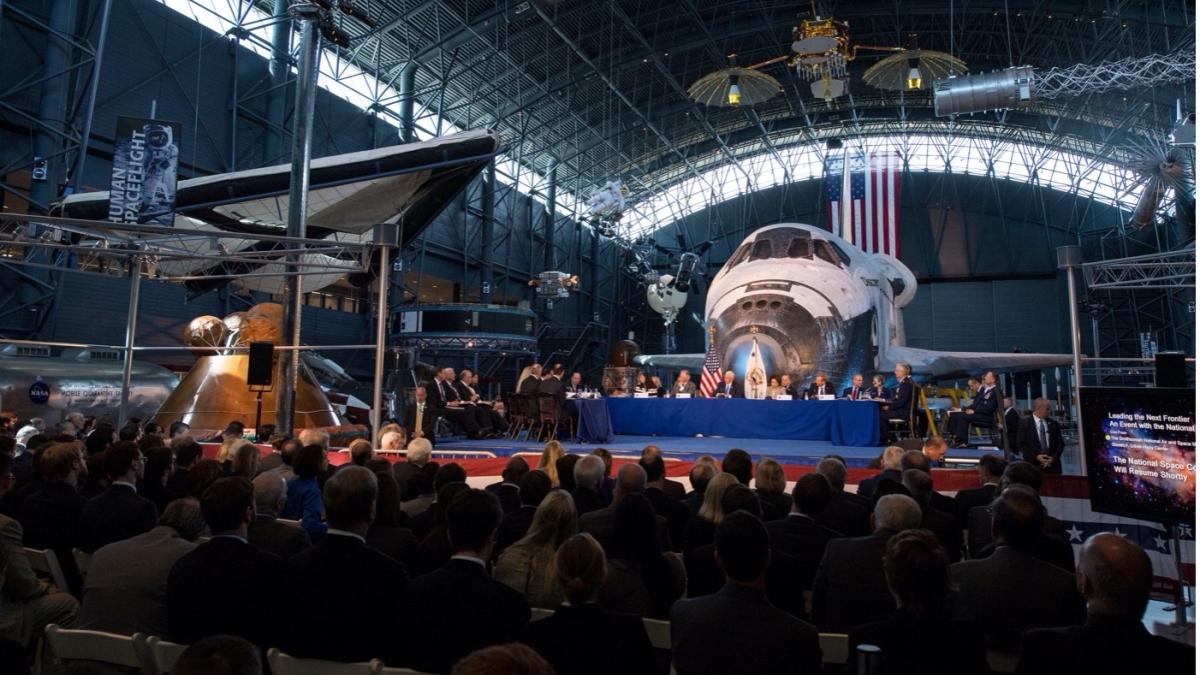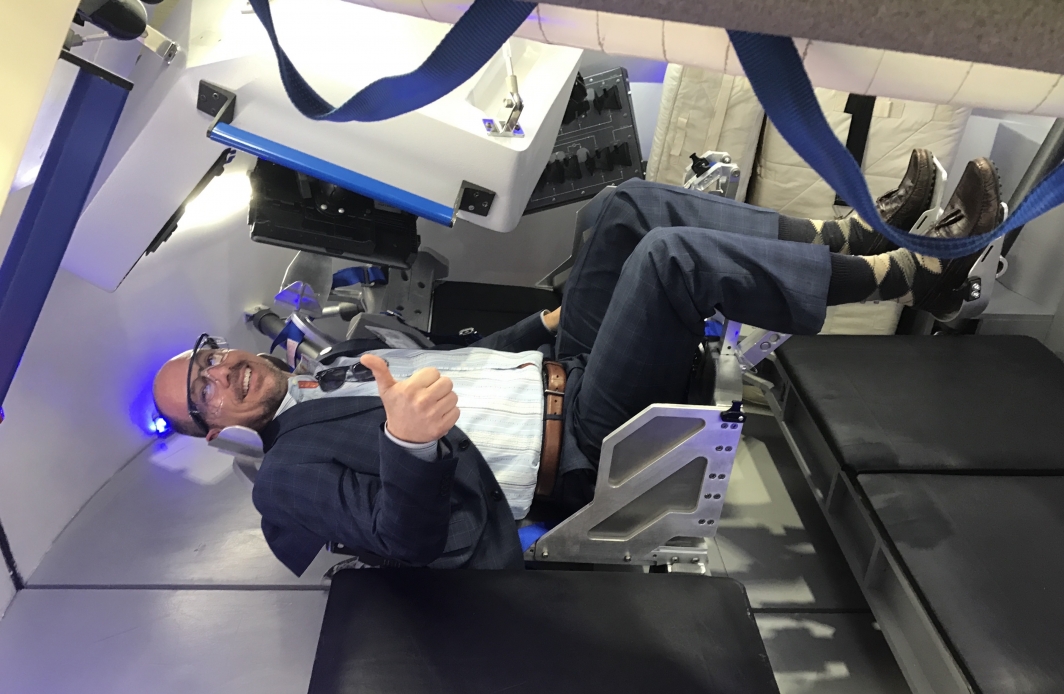Space policy continues to shoot for the moon

National Space Council members during the council's first meeting, Thursday, Oct. 5, 2017, at the Smithsonian National Air and Space Museum's Steven F. Udvar-Hazy Center in Chantilly, Virginia. Photo credit: NASA/Joel Kowsky
The Biden White House has generally made every attempt to distance itself from the Trump administration's policies and messaging. The new president has swiftly committed to significant policy shifts on border enforcement, rejoined the Paris Climate accord and revoked dozens of Trump-era executive orders. But as a recent Washington Post article noted, "There is one area of the former president's policy that Biden has embraced: space."
The new White House has committed to continuing Trump's NASA moon program, keeping the Space Force and maintaining the National Space Council, and also has left Trump's significant national space policy directives in place. That is a consequential development when one considers the fate of previous big-budget space agendas. Decades of stops and starts under changing administrations resulted in NASA celebrating the 50th anniversary of Apollo 11, in 2019, without the ability to fly an American into space.
Greg Autry, who recently joined the faculty of Arizona State University's Thunderbird School of Global Management as a clinical professor of space leadership, policy and business, has direct insights into the development of the ambitious Trump space policy, including how it evolved and garnered industry and political support. Autry served on the NASA agency review team as the White House liaison at NASA and was nominated last year to serve as the space agency's chief financial officer.
Autry joined ASU News to discuss the state of space policy.
Question: What outer space policies were established during the Trump years and why have most received bipartisan support this year?
Answer: The last decade has seen more fundamental U.S. space policy changes than the previous 40 years. The most systemic change has been an accelerated shift toward commercial partnerships as the go-to mechanism for managing new programs at NASA and increasingly at the U.S. Department of Defense. These manifest as fixed-price service agreements rather than government-managed development projects that run on cost-plus contracts.
The reestablishment of the National Space Council is at the core of the new space policy. I'm delighted to note that the Biden administration announced this week that they have decided to continue the council.
The most critical specific programmatic change has been the clear decision to return permanently and sustainably to the moon as both NASA's flagship program and as a national objective for economic development and geopolitical positioning.
Greg Autry
Q: What exactly is the National Space Council and why is it so important?
A: The Space Council was established, along with NASA, in 1958 to ensure that U.S. actions in space were strategically coordinated across federal agencies and departments with interests in space. It traditionally includes the vice president, senior White House officials, the NASA administrator and several cabinet-level officials, including the secretaries of defense, state, commerce and transportation. The NSpC (National Space Council) was last active in 1992.
It was restarted under the Trump administration, chaired by former Vice President (Mike) Pence and ably led by then-Executive Secretary Scott Pace, director of the Space Policy Institute at George Washington University. A large user advisory group was also added to represent the interests of private industry and the greater space community. I'm personally pleased to note that entrepreneur Tim Ellis of Southern California-based Relativity Space joined that group of aerospace CEOs and astronauts at age 27. I've been pleased to occasionally mentor the Relativity founders since they were students at USC when I was on the faculty there.
Q: Why go back to the moon since we've already been there? Why are we not going to Mars at this point?
A: The first Trump space policy directive updated the Obama National Space Policy by adding, "the United States will lead the return of humans to the moon for long-term exploration and utilization," but also included, "… followed by human missions to Mars and other destinations." I suffered an awkwardly amusing moment in the summer of 2019 when I hosted NASA Administrator Jim Bridenstine as the keynote at the International Space Development Conference. As conference chair, I had asked Jim to talk about how the Artemis program would land the first woman on the moon and former President Trump tweeted " ... NASA should NOT be talking about going to the moon ..." The former president wanted the focus on Mars, defense and science. It was good to know he was engaged.
Returning to the moon was probably the most important recommendation of the NASA agency review team I served on in 2016. From the science perspective, the Apollo moon program had been cut short during the Nixon administration before most lunar science could be achieved. In fact, only one actual scientist, Harrison Schmitt, walked on the lunar surface.
We never even discovered the water on the moon! Remote observations show water ice in shaded craters at the lunar poles and possibly locked beneath the lunar regolith, the layer of unconsolidated rocky material covering bedrock. That is interesting for geology and biology and very important for habitation because water and the oxygen it contains are the most essential resources required for a human presence. Getting fuel off the surface of the Earth is the biggest cost factor in space transportation. Lunar water can provide hydrogen fuel and O2 oxidizer. A liter of water on the space station is worth tens of thousands of dollars. Getting propellant from the moon's low gravity is much more attractive for exploring and settling the solar system. It is also likely that valuable ores can be mined from impacted asteroid cores or regolith. Producing spacecraft and other products in space is essential for an efficient space economy and it eliminates the impact of extraction, manufacturing and launch on Earth's biosphere.
Lastly, our geopolitical competitors are aiming for the moon. Although the Outer Space Treaty, to which the U.S. is a signatory, prohibits sovereign land claims, it also forbids interference in other actors' activities, implying that the nations which establish a presence in critical locations — such as those water-bearing craters or the surrounding "peaks of eternal sunlight," offering continuous solar power — will control the future of lunar exploration and development.
That potential source of conflict is why NASA has introduced the Artemis Accords, a series of bilateral agreements with other nations that offers a workable framework for cooperation and interaction in exploring and developing the moon. The accords have been signed by nine spacefaring nations, including important U.S. space partners Japan, the U.K. and Canada. Getting this right up front is vital for the moon and will set precedents for the exploration and development of other celestial bodies.
ASU Professor Greg Autry trying out the Boeing CST-100 Dreamliner at the Kennedy Space Center, Feb. 2017. Photo courtesy Greg Autry
Q: There has been a great deal of interest in private-sector space players' activities, notably Elon Musk, Richard Branson and Jeff Bezos. Are they replacing NASA? How do they fit into the current policy landscape?
A: The first Trump Space Policy Directive updated the Obama-era National Space Policy by calling for "an innovative and sustainable program of exploration with commercial and international partners." The second Trump (Space Policy Directive) called for streamlining regulations for space launch and reentry. The third was focused on managing the critical issue of space traffic and debris. All of these directives are of value to the growing commercial space sector.
The commercial trend started under former President George W. Bush, with the Commercial Orbital Transportation System, which allowed SpaceX and Orbital ATK (now a unit of Northrup Grumman) to build both new rockets and cargo space capsules. This program was supported by the Obama administration and championed by then NASA Deputy Administrator Lori Garver. The Obama team also added a commercial crew program which provides human-rated systems from SpaceX and a Boeing/United Launch Alliance team. The Trump administration's continuation of that program enabled the renewal of American human spaceflight last year.
To be clear, however, this is not a case of replacing NASA. NASA's exploration and technology development missions will continue to push the envelope and private actors may follow, leveraging the accumulated public research knowledge and IP. NASA will work with innovative commercial firms to build spacecraft and launch them. Next summer, the Psyche mission will be launched on a commercial SpaceX Falcon Heavy rocket, which offers better performance at a lower price than was initially anticipated in the plan. That mission, led by ASU's own Lindy Elkins-Tanton, will explore 16 Psyche, a metallic asteroid. While Psyche is designed for and will carry out foundational science about planets' origins, space entrepreneurs will undoubtedly be eagerly watching as they contemplate eventually mining these drifting chunks of valuable metals. Hopefully, such activity may produce a new abundance for humanity and reduce the Earth's industry load.
Q: The Trump administration was arguably more successful in space than in any other policy arena. How did that happen?
A: Well, as the saying goes, "people are policy," and the White House made excellent choices with its space appointments, starting with the NASA agency review team I was on. The ART was composed of a strong group of talented space professionals. The administration was bold enough to put a group of divergent thinkers onto the same team. We didn't always agree, but we respected each other and produced a single, consistent recommendation from which many of the space policies flowed.
I've already noted the choice of Scott Pace to manage the National Space Council. The selection of Jim Bridenstine as NASA administrator didn't come as quick as I would have liked; I was a fan of Jim's perspective on space development and supported his nomination, despite some strong criticism. Many of Jim's former critics, including the former senator who's now the NASA Administrator nominee, Bill Nelson, have apologized and admitted that Jim Bridenstine was the best choice for the job. His careful stewardship and creative thinking were widely admired within the agency and industry.
More Science and technology

Indigenous geneticists build unprecedented research community at ASU
When Krystal Tsosie (Diné) was an undergraduate at Arizona State University, there were no Indigenous faculty she could look to…

Pioneering professor of cultural evolution pens essays for leading academic journals
When Robert Boyd wrote his 1985 book “Culture and the Evolutionary Process,” cultural evolution was not considered a true…

Lucy's lasting legacy: Donald Johanson reflects on the discovery of a lifetime
Fifty years ago, in the dusty hills of Hadar, Ethiopia, a young paleoanthropologist, Donald Johanson, discovered what would…

